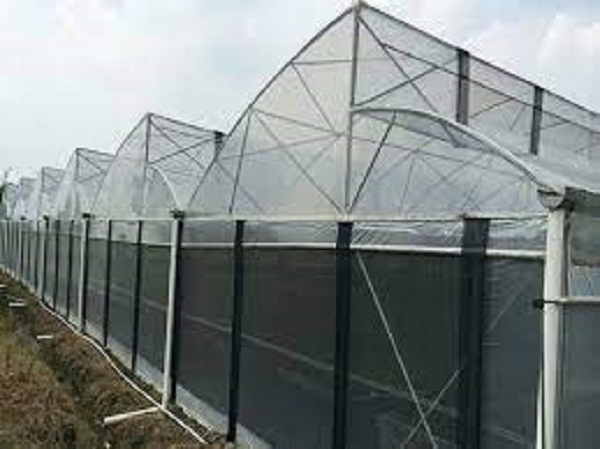
A sawtooth greenhouse is designed with a distinctive roof shape that resembles a saw blade. It is made up of a series of ridges and valleys that alternate along the length of the greenhouse. The ridges are angled at a steep pitch, while the valleys are flat or have a slight slope.
The sawtooth roof design was originally developed in the 19th century to provide natural light and ventilation to industrial buildings, and it was later adapted for use in greenhouses. The steep angles of the ridges allow for maximum exposure to sunlight, while the flat or slightly sloped valleys provide a space for air to circulate and escape.
Sawtooth greenhouses are often used in commercial agriculture and horticulture, as they are well-suited for growing crops that require high levels of light and ventilation, such as flowers, herbs, and vegetables. The design can also help to reduce energy costs by maximizing natural light and ventilation and can be an attractive architectural feature in urban or suburban settings.
History of Sawtooth Greenhouses
The sawtooth greenhouse design has its roots in the Industrial Revolution of the 19th century. The design was first developed to provide natural light and ventilation to factories and other industrial buildings, which were often large and lacked adequate lighting and ventilation.
The sawtooth roof design consists of a series of ridges and valleys that alternate along the length of the building, with the ridges angled at a steep pitch and the valleys flat or slightly sloped. This design allows for maximum exposure to natural light, while also providing a space for hot air to escape and cool air to enter through the lower levels.
In the early 20th century, the sawtooth roof design was adapted for use in greenhouses, which were becoming increasingly popular for commercial agriculture and horticulture. The design was particularly well-suited for growing crops that require high levels of light and ventilation, such as flowers, herbs, and vegetables.
Over the years, sawtooth greenhouses have continued to evolve and improve. Modern sawtooth greenhouses are typically made from lightweight, durable materials such as aluminum and polycarbonate, and often incorporate advanced systems for heating, cooling, and ventilation. Despite these advancements, the basic sawtooth roof design remains a popular choice for many greenhouse growers, due to its effectiveness and aesthetic appeal.
5 Advantages of Sawtooth Greenhouses
Increased Natural Light
The sawtooth roof design maximizes exposure to natural light, which can help to promote plant growth and reduce energy costs.
Improved Ventilation
The alternating ridges and valleys of the sawtooth design allow hot air to rise and escape through the top, while cool air is drawn in through the lower levels. This creates a natural flow of air that can help to regulate temperature and humidity levels and prevent the buildup of moisture and pests.
Energy Efficiency
The sawtooth design allows for maximum use of natural light and ventilation, which can reduce the need for artificial lighting and heating or cooling systems, and lower energy costs.
Aesthetic Appeal
The sawtooth design is visually striking and can enhance the architectural appeal of a greenhouse, making it an attractive feature in both urban and rural settings.
Flexibility
Sawtooth greenhouses can be constructed in a variety of sizes and configurations, making them suitable for a range of applications, from small backyard gardens to large commercial operations.
5 Disadvantages of Sawtooth Greenhouses
Cost
The sawtooth design requires more materials and labor to construct than some other greenhouse designs, which can increase the initial cost of building a sawtooth greenhouse.
Complex Maintenance
The sawtooth design can make maintenance tasks, such as cleaning the roof or repairing damage, more complex and time-consuming.
Limited Headroom
The steep angles of the ridges can limit headroom inside the greenhouse, which may make it difficult to grow taller plants or access the upper levels for maintenance.
Weather Resistance
The sawtooth design can be less resistant to high winds or heavy snow loads, which may require additional structural support or maintenance.
Limited Customization
The sawtooth design is a distinctive architectural style that may not be suitable for all properties or applications and may limit customization options.
Related Articles & Free Email Newsletter Sign Up
Gable Greenhouses Offer Lots of Growing Space and Structural Stability
Geodesic Greenhouses Offer a Unique and Strong Design
Gothic Style Greenhouses Add a Touch of Historical Beauty to a Property



Comment here